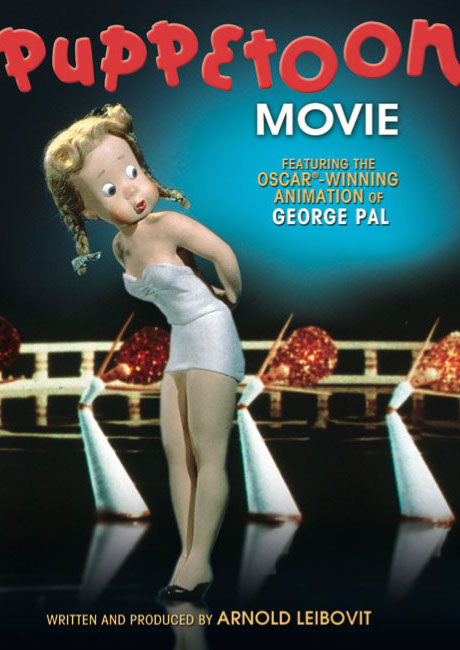Friday, July 24, 1987.
THE PUPPETOON MOVIE. Music by Norman D. “Buddy” Baker. Animated by Peter Kleinow. Written and voice directed by Arnold Leibovit. Running time: 78 minutes. General entertainment.
GEORGE PAL UNDERSTOOD LEGENDS. It was isms that gave him trouble.
Fascism, for example. It became popular in Germany just after the Hungarian-born animator established himself in Berlin.
Though he’d spent two years running the cartoon shop at the huge UFA studios, and another as an independent producer, his foreign roots still made him suspect to the agents of the Gestapo. In 1933, Pal moved, going first to Paris and then to Eindhoven, Holland.
During his Berlin residency, he had come up with the idea of using stop-motion photography to animate three-dimensional objects. In the Netherlands, he began calling his creations “puppet cartoons,” quickly shortening the phrase into the trade name “Puppetoon.”
In 1939, with Hitlerism on the move, the filmmaker relocated to New York. There, Paramount pictures signed him to a contract, and Pal packed his bags for one last trip — to Hollywood.
Pal was well on his way to becoming a legend when he encountered racism. In developing properties for the U.S. market, he’d created Jasper, a trouble-prone child whom he called “the Huckleberry Finn of American folklore.”
Jasper was a Negro. Black American critics called him a stereotype, and his creator a racist. Stung, Pal responded by animating the story of John Henry, turning the tale of the legendary steel-driving man into a heroic fantasy.
His efforts won praise, and an Academy Award nomination. The picture, included in Pal acolyte Arnold Leibovit’s reverential compilation feature The Puppetoon Movie, ends with a prescient commentary on the subject of legend.
“Even if John Henry wasn’t as big as the stories say he was,” says Preacher (the voice of Rex Ingram) delivering a eulogy, “he was still a mighty man . . .” The same can be said of Pal.
In a wonderfully imaginative animated introduction, praise is heaped upon the Puppetoon master. According to Arnie (voice of Paul Frees), a personable dinosaur, Pal brought “a new form of magic into the world.”
Historically, a better case can be made for King Kong animator Willis O’Brien as the original stop-motion master. Leibovit, in writing Arnie’s lines, unnecessarily embellishes the Pal legend.
On his own, George Pal was still a mighty man, as this selection of 11 Puppetoons produced between 1937 and 1947 ably demonstrates.
Jasper is represented, as are Pal’s Dutch-made jazz tempo version of The Sleeping Beauty (1938), his powerful anti-Nazi Oscar nominee Tulips Shall Grow (1942) and his 1947 Oscar nominee Tubby the Tuba.
As a producer, his feature films — among them 1950’s Destination Moon, When Worlds Collide (1951), The War of the Worlds (1953) and The Time Machine (1960) — often were special effects Oscar winners, a fact that’s tended to obscure his earlier, lighter achievements.
The Puppetoon Movie is a welcome reminder of the decade that he devoted to music and comedy.
The above is a restored version of a Province review by Michael Walsh originally published in 1987. For additional information on this archived material, please visit my FAQ.
Afterword: For the generation that attended the first Vancouver SF Convention in 1971, George Pal’s greatness was a given. The Hollywood films that he’d produced and/or directed shaped their idea of how the future would look. Pal appreciated the genre’s master writers, and produced director Irving Pichel’s Destination Moon, the first feature film based on a Robert Heinlein novel (1947’s Rocketship Galileo). He followed that with director Rudolph Maté’s apocalyptic When Worlds Collide, an adaptation of the 1933 novel co-written by Philip Wylie and Edwin Balmer. Among fans, Pal was best known for his H.G. Wells adaptations — The War of the Worlds, directed by Byron Haskin, and The Time Machine, the second feature helmed by Pal himself.
Pal made his feature directorial debut in 1958 with tom thumb, a return to his European fantasy roots that was filmed in London. Based on the Jacob Grimm tale of a doll-sized man, it was a musical and, of course, an Oscar winner for its special effects. His fourth directorial outing was a spectacular biographical fantasy, The Wonderful World of the Brothers Grimm (1962), the seventh film made in the triple-screen Cinerama process, and the first Cinerama picture to have a dramatic storyline. Although his last two films as a producer — Byron Haskin’s The Power (1968) and Michael Anderson’s Doc Savage: The Man of Bronze (1975) — were not big hits, George Pal lived long enough to hear his praises sung in the opening to Jim Sharman’s 1975 cult classic The Rocky Horror Picture Show: “But When Worlds Collide / Said George Pal to his bride / I'm gonna give you some terrible thrills / Science fiction double feature . . .” The sci-fi cinema pioneer died in 1980 at the age of 72.
